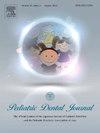Longevity of retained deciduous teeth: A retrospective cohort study
IF 0.6
Q4 DENTISTRY, ORAL SURGERY & MEDICINE
引用次数: 0
Abstract
Objective
This study aimed to investigate the factors related to the survival of retained deciduous teeth (RDTs).
Materials and methods
RDTs were identified in panoramic X-ray images in 13,516 patients at Nagasaki University Hospital from 2014 to 2018. The survival status of the RDTs was tracked using medical records; survival rates were calculated. The RDTs were divided into two groups: before and after the completion of stable permanent dentition. A shared frailty analysis was performed in each group, estimating hazard ratios and 95% confidence intervals for variables related to survival.
Results
A total of 138 patients (50 male and 88 female participants, 1.02%) had RDTs. The total number of RDTs was 274, with survival rates of 62.48% at 10 years and 53.30% at 20 years. Before the completion of permanent dentition, the longevity of RDTs was associated with two variables: tooth type (anterior/molar) and presence or absence of successive permanent teeth. No variables were associated with RDT survival after permanent dentition was stabilized.
Conclusion
Multiple congenital factors affect the longevity of RDTs before the stabilization of permanent dentition. However, no significant influence was observed based on factors identified retrospectively after the permanent dentition was stabilized.
保留乳牙寿命:一项回顾性队列研究
目的探讨影响保留乳牙成活的相关因素。材料与方法对2014 - 2018年长崎大学附属医院13516例患者的全景x线图像进行srdt鉴定。使用医疗记录跟踪rdt的生存状态;计算生存率。rrt分为两组:稳定恒牙列完成前和完成后。在每组中进行共同的脆弱性分析,估计与生存相关的变量的风险比和95%置信区间。结果共有138例患者(男性50例,女性88例,占1.02%)接受了随机对照试验。rdt总数为274例,10年生存率为62.48%,20年生存率为53.30%。在完成恒牙列之前,rdt的寿命与两个变量相关:牙齿类型(前牙/磨牙)和是否存在连续的恒牙。恒牙列稳定后,没有与RDT存活相关的变量。结论在恒牙列稳定前,多种先天性因素影响着rdt的寿命。然而,在恒牙列稳定后,回顾性发现的因素并没有明显的影响。
本文章由计算机程序翻译,如有差异,请以英文原文为准。
求助全文
约1分钟内获得全文
求助全文
来源期刊

Pediatric Dental Journal
DENTISTRY, ORAL SURGERY & MEDICINE-
CiteScore
1.40
自引率
0.00%
发文量
24
审稿时长
26 days
 求助内容:
求助内容: 应助结果提醒方式:
应助结果提醒方式:


